How To Cook On A Camping Trip
If you click and purchase with one of our links, we earn a commission. Thanks.
A portable gas stove is the best way to cook when camping. When you are learning how to cook on camping trip you will be tempted to only cook over a campfire. Campfire cooking takes too long, requires more skill, and can’t be used during burn bans.
Table of Contents
- Camping Cooking Packing List
- Types of Camp Cooking Methods
- Essential Camping Cooking Gear
- Preparing and Packing Food for Camping
- Safety Precautions while Cooking
- Cleaning and Maintenance
- Favorite Recipes
I surveyed my Facebook page and asked them whether the preferred to cook with campfire or gas stoves.
The winner was both depending upon what they were cooking and the weather.
Though we all agreed that anything cooked over a campfire tastes better.
If you are just getting started with camping don’t forget to check out first-time campers guide.
Camping Cooking Packing List
| Item | Purpose | Quantity |
| Portable stove | Cooking | 1 |
| Fuel canister | Powering the stove | 2-3 |
| Cooking utensils | Preparing and serving food | 1 set |
| Pots and pans | Cooking gear | 2-3 |
| Cooler/fridge | Storing perishable food items | 1 |
Camping often sheds modern comforts, drawing one nearer to nature. A joy of camping is cooking outdoors. Different methods fit various camping types, be it car camping or backpacking into the wilderness. Here are methods that are the best when you learning how to cook on a camping trip.
Campfire Cooking
Nothing screams camping more than a campfire. It’s not just a source of warmth and a great way to create a cozy ambiance; it’s also a versatile cooking tool. Here’s a glimpse into the rustic charm of campfire cooking:
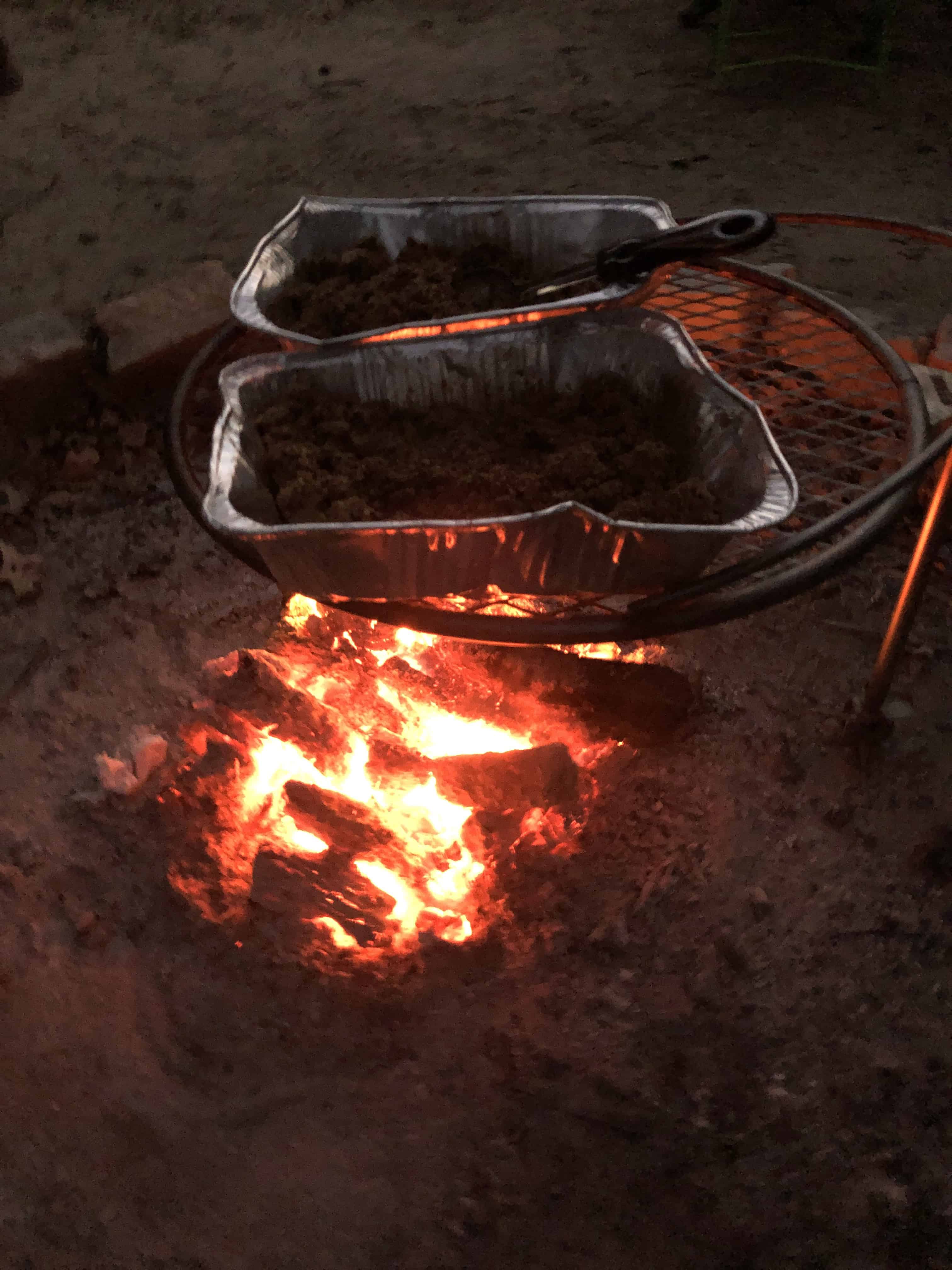
Caveman Cooking
I visited the Texas Survival School years ago. We could bring any food for dinner. I brought a steak for the campfire, but the leader, with the grates, was late.
I cooked my steak directly on the coals, or “Caveman Style.”
Campfire Preparation
A good cooking fire differs from a recreational one. The latter suits group enjoyment, while the former needs a bed of hot coals. Once flames subside, leaving hot coals, you’re ready to cook.
Over many years running group campfires, I’ve learned to have multiple fires if cooking is planned.
This way, the group enjoys a recreational fire, while a smaller cooking fire is maintained.
Learn more about a building a campfire.
Other Campfire Cooking Methods
While I think camping stoves will be better options for most campouts, there are three simple methods for cooking over a campfire.
The first is to cook hot dogs or sausages on a stick. A classic meal that is fun for the kids.
You can also cook kebabs using skewers.
You can also cook meals on campfires using foil-packed meals. Check out our recipe here.
Portable Stoves
When convenience and speed are priorities, portable stoves are the go-to. They come in various types of camping fuel to suit different camping needs:
Propane Gas Stoves
Portable propane gas stoves excel in car camping. They’re fast, simple, reliable—easing meal preparation outdoors.
For family campouts, I recommend one with at least two burners. Even with a one-pot meal, there’s always need for boiling water—for coffee or hot chocolate.
Isobutane Stoves
For backpackers, isobutane stoves shine. They’re compact, lightweight—easy to pack and tote on the trail.
Many backpackers on YouTube or TikTok emphasize long-distance hiking, showcasing mainly freeze-dried or instant ramen meals.
Yet, backpacking isn’t always a long hike. It might be a short trek to a primitive site from a front country campsite in a national or state park.
With a skillet, a wider meal range is achievable.
White Gas
White gas or “Coleman Fuel” is similar to gasoline.
There are three benefits to white gas over other petroleum fuels like propane or isobutane.
The first benefit is that it provides more temperature control while cooking. The second benefit is that you visually see how much fuel you have in the bottle. The third benefit is that it will ignite under very cold conditions.
There are significant drawbacks to white gas. The first being that it takes a lot more effort to light a white gas stove. You must prime the stove and this takes practice to light it up consistently. The second drawback is that you can easily spill the fuel. Propane and isobutane do not have this problem.
Dutch Oven
If you do want to try and cook with a campfire then use a Dutch oven. You can cook almost anything in them.
One of the benefits of learning how to cook while camping with a Dutch oven is that you can bake with a Dutch oven. You cannot bake with a gas stove.
If you don’t want to deal with a campfire or are under a burn ban, you can use charcoal briquettes. I’ve been told a rule of thumb for cooking with charcoal is to assume 25 F of temperature per lit briquette. That allows you to do simple math about how to spread the coals around your oven.
Even under burn bans, charcoal is often allowed as long they are in a grill.
Always check with the local regulations.
If you want to learn how to cook with a Dutch Oven check out my book here.
No Cook Meals
You can also bring salads or sandwiches for no-cook meals. These are great for lunch when you don’t want to spend a lot of time cooking.
It can also be fun to explore the nearby town for lunch spots. I often end up at a local BBQ or non-chain hamburger spot.
Essential Camping Cooking Gear
Chuck Box
A chuck box or camp kitchen, is your central hub for storing all your cooking gear.
This can be a specific portable pantry or just a plastic tub that keeps everything together. A chuck box is essential because while we can cook almost anything outdoors, we need to make sure we have all of the equipment to do so.
Tools and Utensils
Ensure you have the proper cooking equipment.
You don’t need to go overboard—some home pots and pans, a knife, spatula, and tongs should suffice.
Pack a portable table. At campsites, horizontal space is prized. Even with a picnic table, it’s often cluttered. A portable table expands your cooking space.
Portable stoves and fuel sources
Have ample fuel for your stove. Larger gas stoves use propane, while backpacking stoves favor isobutane.
In cold or high-altitude conditions, white gas is the go-to fuel.
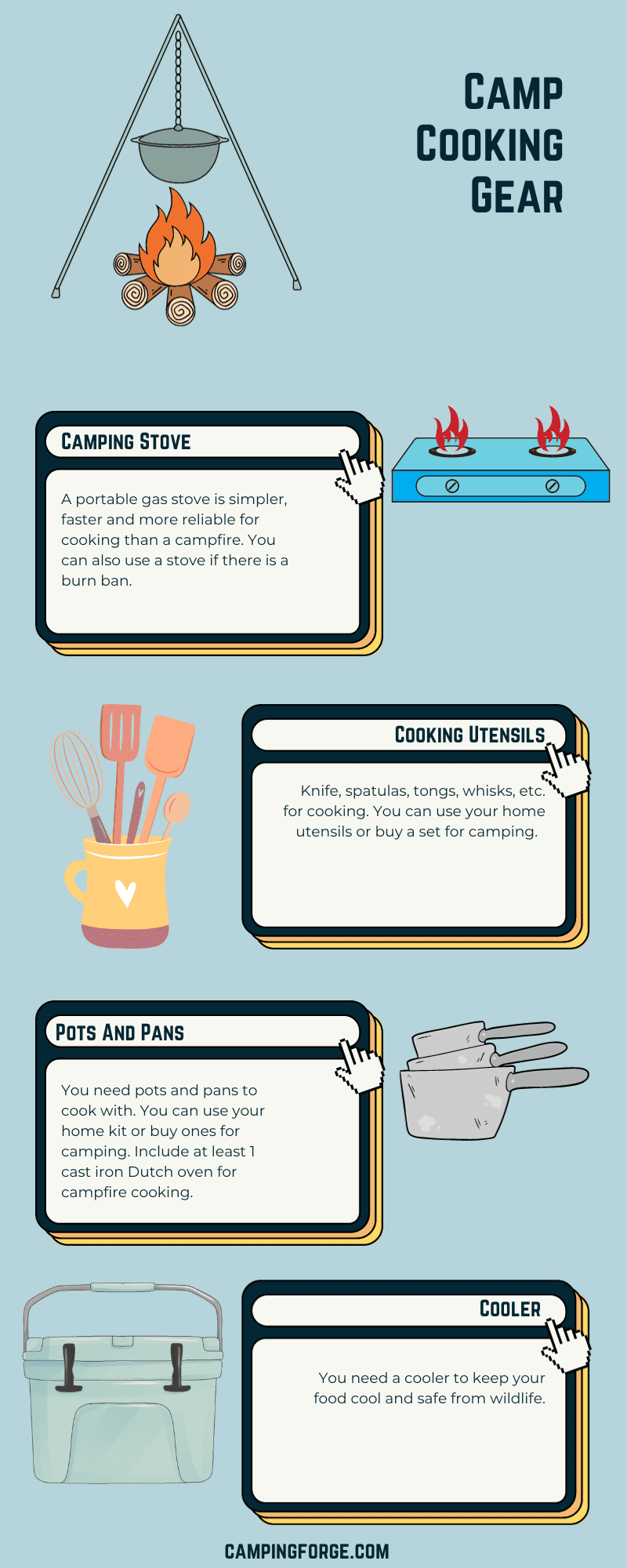
Read more about essential camping cookware here
Preparing and Packing Food for Camping
Enjoying cooking doesn’t mean spending hours on it during a campout. Camping is for relaxation.
If an ingredient is forgotten, there’s no nearby store or delivery app to rely on.
Except in Cedar Hill State Park, Texas, where being in downtown Dallas, DoorDash is an option.
Before campouts, we plan meals. My wife shops for us, though she doesn’t camp with us.
She’d let me shop or use an app, but her mom prefers a weekly store run.
Meal Planning And Prepping
Meal planning is crucial for a campout. At home, dinner arguments are unwanted; on a campout, restaurant options are scarce.
Prep food ahead—chop fruits and veggies, or pre-make meals like chili to reheat on-site. It’s ideal for flavor-rich dishes like chili or stews.
How to Pack Food
Even a campout with just my buddy Scott fills my pickup or SUV’s storage quickly.
Enjoying cooking doesn’t mean spending hours on it during a campout. Camping is for relaxation.
If an ingredient is forgotten, there’s no nearby store or delivery app to rely on.
Except in Cedar Hill State Park, Texas, where being in downtown Dallas, DoorDash is an option.
Before campouts, we plan meals. My wife shops for us, though she doesn’t camp with us.
She’d let me shop or use an app, but her mom prefers a weekly store run.
Meal Planning And Prepping
Meal planning is crucial for a campout. At home, dinner arguments are unwanted; on a campout, restaurant options are scarce.
Prep food ahead—chop fruits and veggies, or pre-make meals like chili to reheat on-site. It’s ideal for flavor-rich dishes like chili or stews.
How to Pack Food
Even a campout with just my buddy Scott fills my pickup or SUV’s storage quickly.
Safety Precautions while Cooking
When you are camping there are specific steps we need to take to make sure to keep our food safe. There are two types of danger - spoilage and wildlife.
The best way to keep your food safe from going bad is to keep it cold in a cooler. I’m a big fan of the Yeti cooler. You can read my complete review here.
The Yeti cooler is also great for protecting against wildlife. The handles cannot easily be opened by raccoons or bears. There are even holes to place locks or bolts for further protection.
You should also store food in bear lockers if they are provided at your campground. If you are backpacking the park might require you to use bear canisters.
I also have an article on alternatives to bear canisters that you can use if given the option.
Preparing Your Cook Area
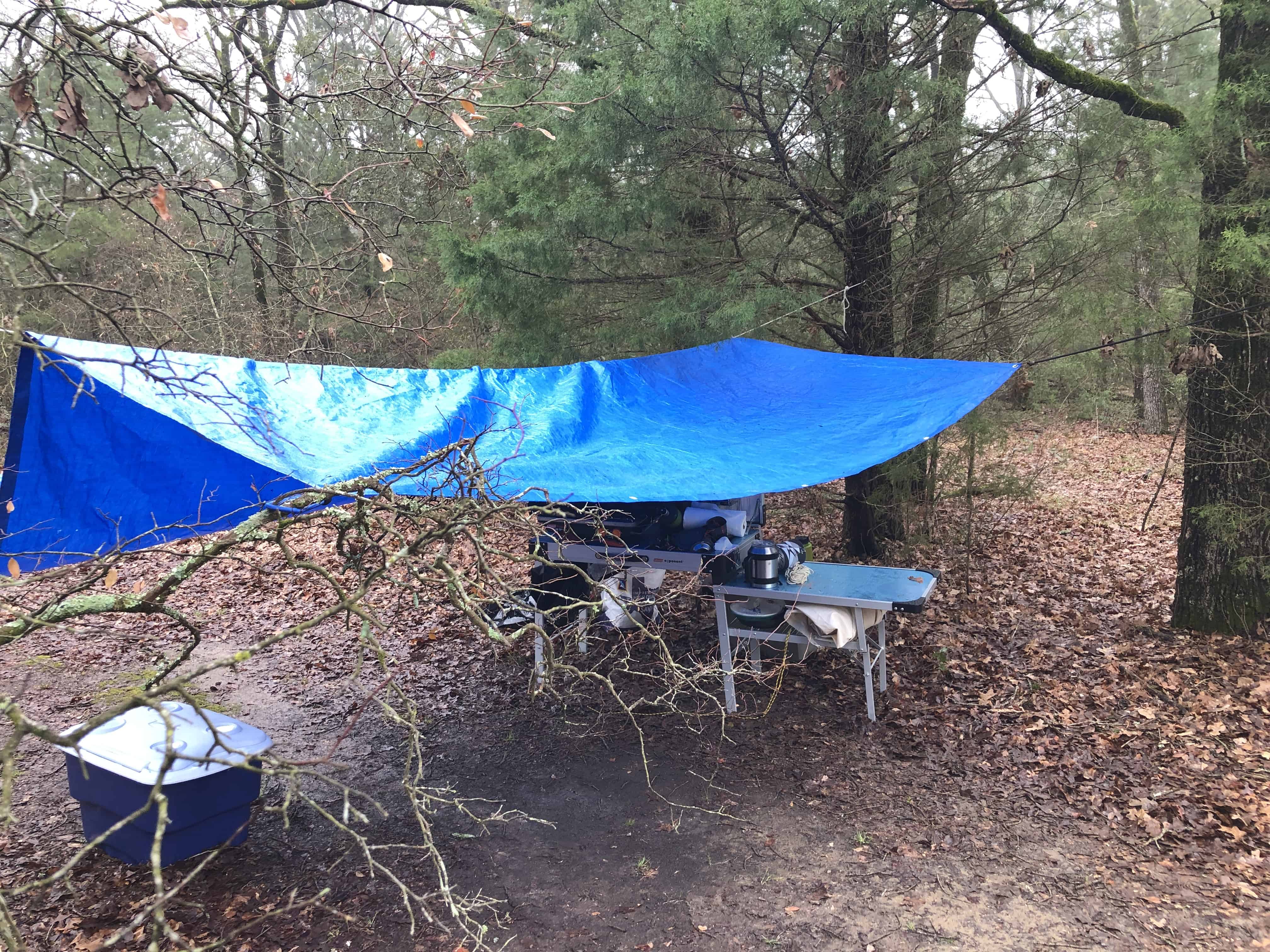
Keep your cooking area at least 200 feet downwind of your tents. This protects against fire and bears.
If you are expecting rain you should also keep a tarp over your cooking area. Keep the tarp at least a foot over your head to reduce the risk of fire. You need to keep the area well ventilated which should not be a problem as long as you are using a tarp covering.
Storing Your Food
You need to keep your fresh food, specifically, meat and eggs in a cooler to keep it from spoiling. You also need to keep your fresh and dry foods protected from the weather such as rain and snow.
If you are camping in bear country then make sure to keep your food stored in available bear lockers. It is tempting to keep food stored in your car to prevent bears from getting the food. But if bears are in the campgrounds and they know that food is in cars, they will destroy your car to get to the food.
So use a bear locker.
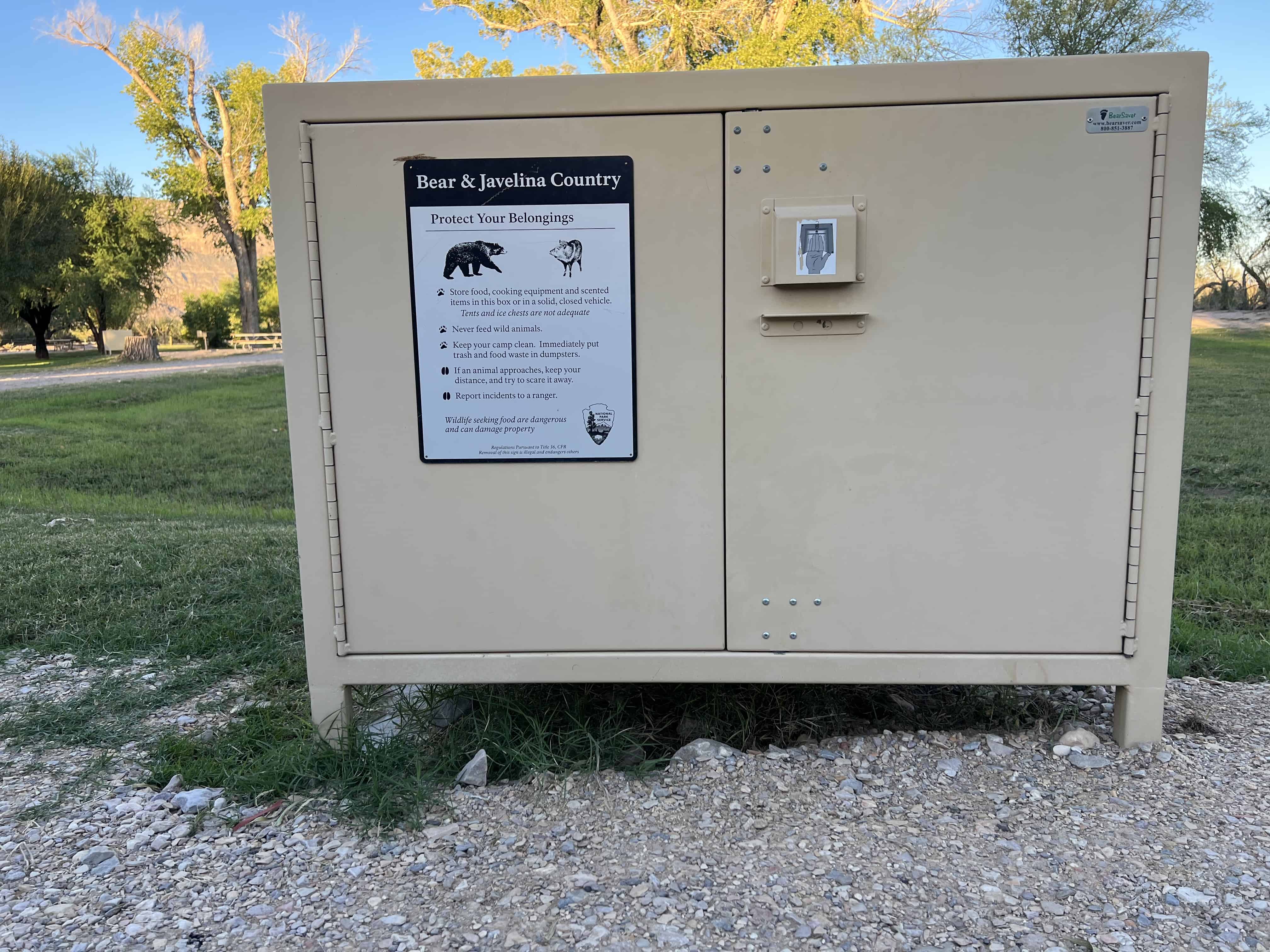
If you are dispersed camping then use bear-resistant storage options such as certified coolers, bear canisters or Ursa sacks.
Even if you do not need to worry about bears, other animals can steal your food.
I have seen raccoons open a traditional cooler. This is why I bought my Yeti.
I have had raccoons nudge open a door to a shelter (I didn’t realize the door wouldn’t stay shut unless you lock the door) and sneak in to steal food while I was sleeping in the shelter.
Learn more about camping in bear country
Cleaning and Maintenance
It is important to keep your campsite clean and your camping gear maintained. This will reduce the chances of getting sick from leftover food, keep animals away from your campsite and leave the campsite for others to enjoy.
Cleaning a Camping Stove
Regular maintenance will extend the life of your stove and ensure it works efficiently. A clean stove also reduces the risk of flare-ups. Here’s a guide on how to clean your camping stove properly.
Leave No Trace
The great outdoors is our shared space. Always clean up after yourself, pack out all trash, and leave your campsite as you found it.
Proper Waste Disposal
Use biodegradable soap when washing dishes and ensure all wastewater is disposed of at least 200 feet away from water sources. Here’s an article on how to stay clean while camping.
Favorite Recipes
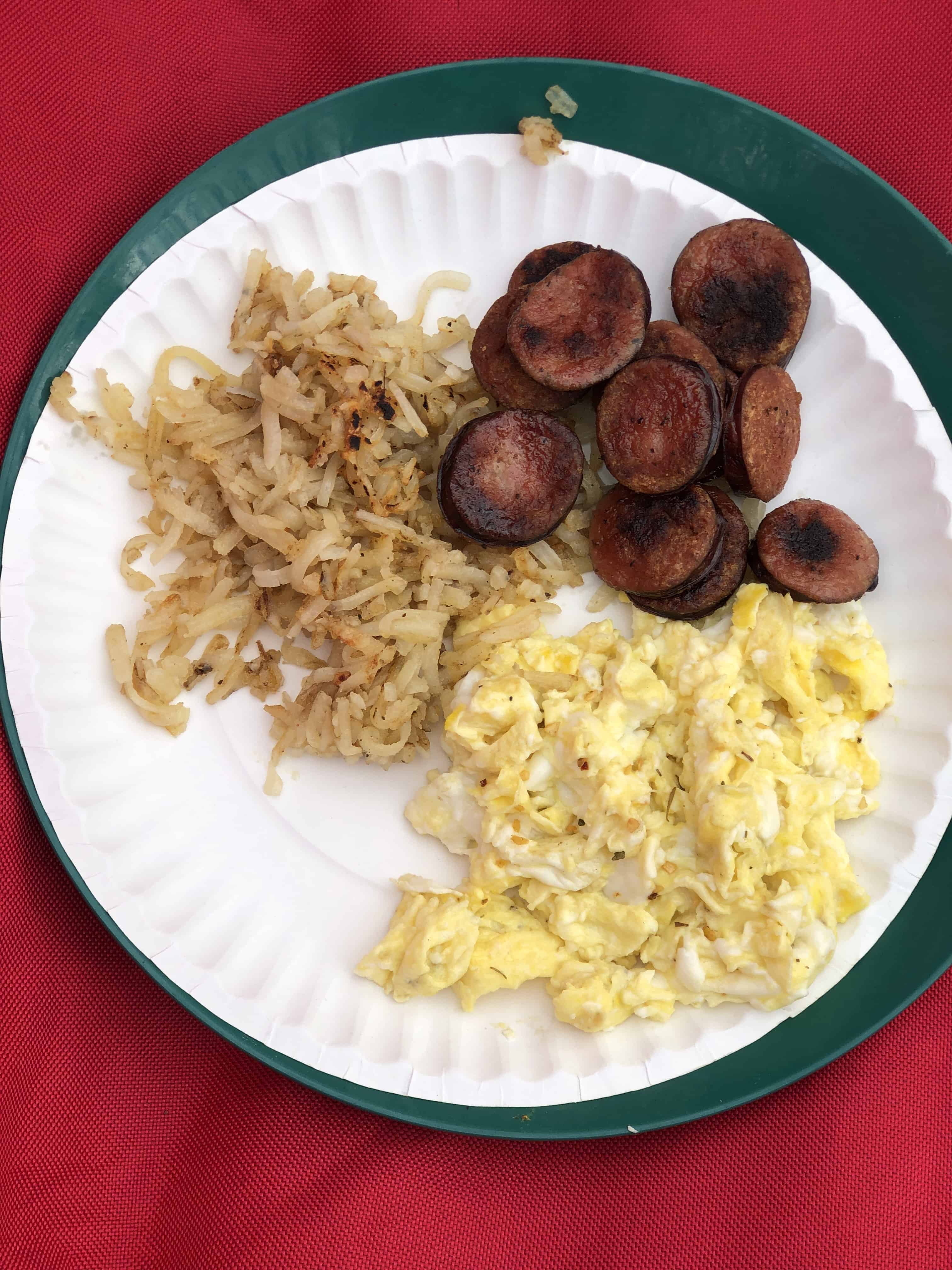
If you want a simple dish that is a twist on chili dogs then check out our stuffed hot dog recipe.
If you want to do Thanksgiving dinner at a campout then see our recipe for campfire turkey.
If you are tired of boring tuna fish then check out our 101 recipes for canned tuna.
If you want even more recipes then see our 101 options here.
Finally, don’t forget to learn how to pack and get your cooking gear to the campsite.
Frequently Asked Questions
- What is the best way to cook when camping?
- The best way to cook while camping largely depends on your personal preferences and the resources at your disposal. Common methods include using a portable gas stove, campfire cooking, and utilizing a portable grill. Each has its own set of benefits and challenges.
- What equipment do I need to cook on a camping trip?
- Essential cooking equipment includes a portable stove or grill, fuel, pots and pans, cooking utensils, a cooler for perishables, and fire-starting materials if you plan to cook on a campfire.
- How do I keep food fresh while camping?
- Investing in a high-quality cooler can keep perishables fresh. Also, consider packing frozen or pre-chilled food, which can help keep other items cool.
- Is it safe to cook over a campfire?
- Yes, it’s safe provided you follow basic safety precautions. Always build your campfire downwind, away from your tent and ensure it’s fully extinguished before leaving the site or going to sleep.
- What are some easy meals to cook while camping?
- Simple one-pot meals, foil packet meals, and skewers are easy and delicious. Pre-made meals that just need heating up are also convenient.
- How do I plan meals for a camping trip?
- Start by planning your menu, considering the number of meals needed, and the cooking equipment you’ll have. It’s helpful to do as much prep work as possible at home.
- What should I do if there’s a burn ban?
- If there’s a burn ban, abide by the rules and use alternative cooking methods like a portable gas stove, which is usually allowed even during burn bans.
- How do I clean up after cooking while camping?
- Use biodegradable soap to clean dishes and dispose of wastewater at least 200 feet from water sources. Follow Leave No Trace principles to minimize your impact.
- How do I store leftovers while camping?
- Store leftovers in airtight containers in a cooler to keep them fresh. Ensure the cooler is well-insulated to keep the food cold.
- Are there any wildlife precautions I should take when cooking and storing food?
- Yes, store food in bear-resistant containers or lockers if in bear country, and keep your cooking area clean to avoid attracting wildlife.